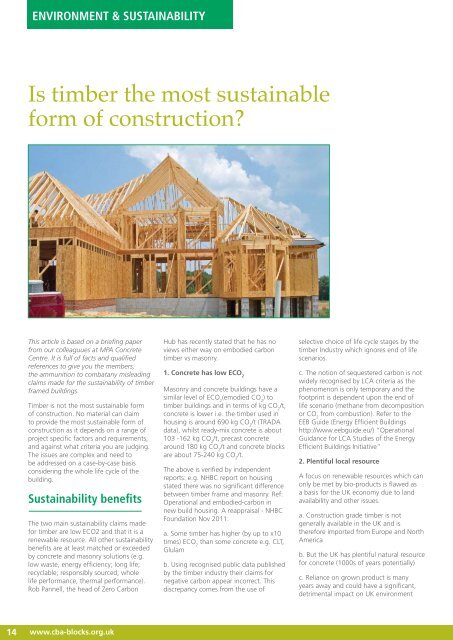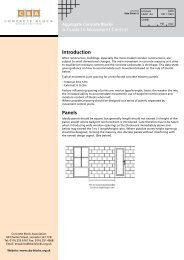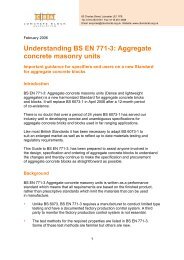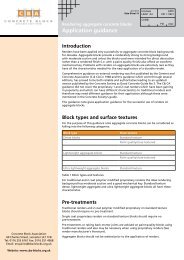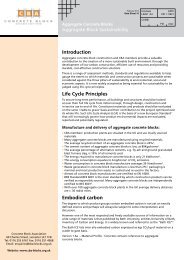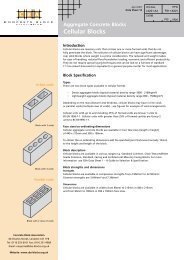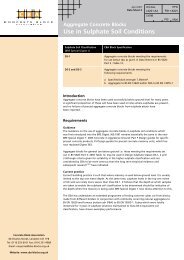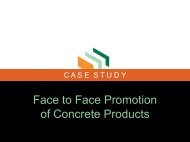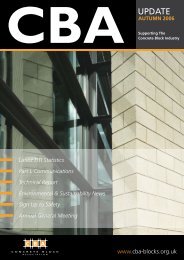Latest CBA Newsletter - Concrete Block Association
Latest CBA Newsletter - Concrete Block Association
Latest CBA Newsletter - Concrete Block Association
Create successful ePaper yourself
Turn your PDF publications into a flip-book with our unique Google optimized e-Paper software.
environment & sustainability<br />
Is timber the most sustainable<br />
form of construction?<br />
This article is based on a briefing paper<br />
from our colleaguues at MPA <strong>Concrete</strong><br />
Centre. It is full of facts and qualified<br />
references to give you the members,<br />
the ammunition to combatany misleading<br />
claims made for the sustainability of timber<br />
framed buildings.<br />
Timber is not the most sustainable form<br />
of construction. No material can claim<br />
to provide the most sustainable form of<br />
construction as it depends on a range of<br />
project specific factors and requirements,<br />
and against what criteria you are judging.<br />
The issues are complex and need to<br />
be addressed on a case-by-case basis<br />
considering the whole life cycle of the<br />
building.<br />
Sustainability benefits<br />
The two main sustainability claims made<br />
for timber are low ECO2 and that it is a<br />
renewable resource. All other sustainability<br />
benefits are at least matched or exceeded<br />
by concrete and masonry solutions (e.g.<br />
low waste, energy efficiency; long life;<br />
recyclable; responsibly sourced; whole<br />
life performance, thermal performance).<br />
Rob Pannell, the head of Zero Carbon<br />
Hub has recently stated that he has no<br />
views either way on embodied carbon<br />
timber vs masonry.<br />
1. <strong>Concrete</strong> has low ECO 2<br />
Masonry and concrete buildings have a<br />
similar level of ECO 2<br />
(emodied CO 2<br />
) to<br />
timber buildings and in terms of kg CO 2<br />
/t,<br />
concrete is lower i.e. the timber used in<br />
housing is around 690 kg CO 2<br />
/t (TRADA<br />
data), whilst ready-mix concrete is about<br />
103 -162 kg CO 2<br />
/t, precast concrete<br />
around 180 kg CO 2<br />
/t and concrete blocks<br />
are about 75-240 kg CO 2<br />
/t.<br />
The above is verified by independent<br />
reports: e.g. NHBC report on housing<br />
stated there was no significant difference<br />
between timber frame and masonry. Ref:<br />
Operational and embodied-carbon in<br />
new build housing. A reappraisal - NHBC<br />
Foundation Nov 2011:<br />
a. Some timber has higher (by up to x10<br />
times) ECO 2<br />
than some concrete e.g. CLT,<br />
Glulam<br />
b. Using recognised public data published<br />
by the timber industry their claims for<br />
negative carbon appear incorrect. This<br />
discrepancy comes from the use of<br />
selective choice of life cycle stages by the<br />
timber Industry which ignores end of life<br />
scenarios.<br />
c. The notion of sequestered carbon is not<br />
widely recognised by LCA criteria as the<br />
phenomenon is only temporary and the<br />
footprint is dependent upon the end of<br />
life scenario (methane from decomposition<br />
or CO 2<br />
from combustion). Refer to the<br />
EEB Guide (Energy Efficient Buildings<br />
http://www.eebguide.eu/) “Operational<br />
Guidance for LCA Studies of the Energy<br />
Efficient Buildings Initiative”<br />
2. Plentiful local resource<br />
A focus on renewable resources which can<br />
only be met by bio-products is flawed as<br />
a basis for the UK economy due to land<br />
availability and other issues.<br />
a. Construction grade timber is not<br />
generally available in the UK and is<br />
therefore imported from Europe and North<br />
America<br />
b. But the UK has plentiful natural resource<br />
for concrete (1000s of years potentially)<br />
c. Reliance on grown product is many<br />
years away and could have a significant,<br />
detrimental impact on UK environment<br />
14 www.cba-blocks.org.uk


